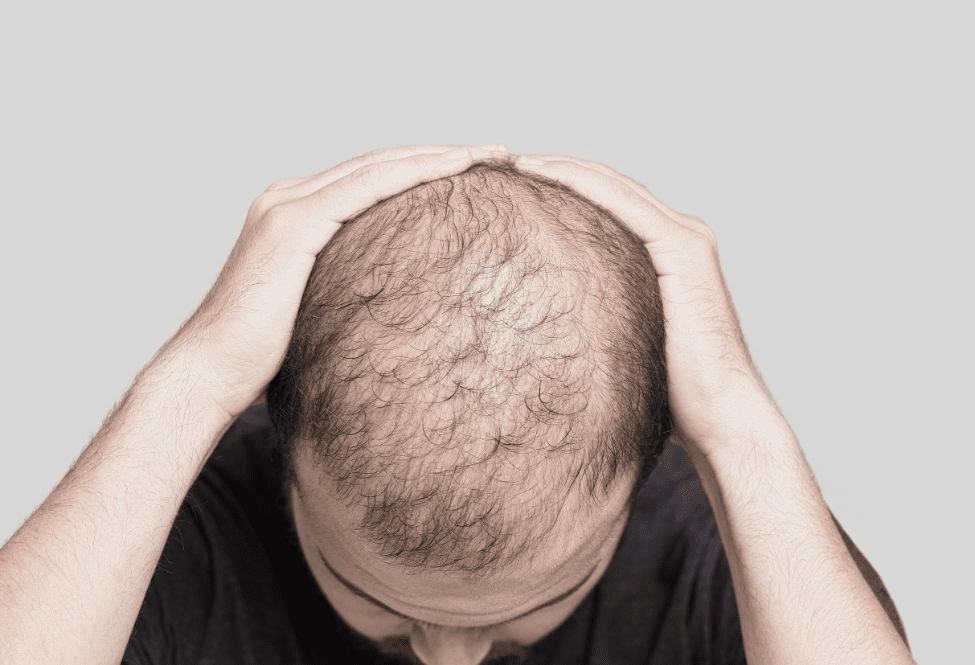Hair loss mostly occurs in men. A staggering 85% of men experience some sort of hair loss over the age of 50. Overall, around 60% of men get affected by hair loss. It mostly happens due to genetics but can also occur due to stress, fatigue, trauma, and more. Thankfully, a lot can be done about baldness nowadays. There are numerous effective treatments and solutions to enrich your hair once more. The most common treatment is based on minoxidil which slows down hair loss and in some cases even leads to hair regrowth.
To learn more, keep reading the article by Dr. Andrea Garbea.
Hair loss is a typical male disease. On average, 6 out of 10 men are affected, compared to only 2 out of 10 women. Even worse, the disease causes complexes in most affected men: depressive moods, low self-esteem, the feeling of ageing too quickly ….
This is all the more problematic because hair loss starts in the twenties for a quarter of those affected. We apologise in advance to all readers over 50, but the figures are unfortunately clear: almost 85% of men aged 50 suffer from severe hair loss, which is easily recognisable in front of the mirror in the morning. Fortunately, however, something can be done! There are effective solutions and treatments that make hair fuller again. We spoke to Dr Andrea Garbea, who has been a dermatologist in Lutry for almost 20 years, about the causes of the problem and the treatment options. So please be sure to read on, if you haven’t already thrown in the towel and banned the hairbrush from the bathroom and resorted to the razor.
DR. GARBEA, EXPLAIN TO US WHAT BALDNESS OR ALOPEZIA IS
Baldness and alopecia have the same meaning, both terms describe the phenomenon of accelerated hair loss. We all lose our hair throughout life, sometimes very late, but these terms describe premature hair loss. In common parlance, baldness is also used to describe hereditary hair loss in men. The term alopecia is usually used when hair falls out sporadically or bald patches appear. Hair loss is considered pathological when 60 to 100 hairs fall out every day. There are, of course, visible signs that indicate this, for example, a forehead that becomes increasingly high, bald patches at the temples or on the middle of the head, and increasingly finer, thinner hair. Baldness is very common in men, affecting almost 60% of the male population. It begins on average between 20 and 35 years of age, but can also become noticeable earlier or later. The proportion of women affected is lower, with around 30% suffering from hair loss around the age of 40.
WHY DOES HAIR FALL OUT?
Genetics is responsible for hair loss in almost 90% of cases. The main cause is an excess or sensitivity to male hormones, an excess is very often hereditary. If your father suffers from hair loss, chances are that you will also be affected at some point. However, sometimes generations are skipped, so that a great uncle can also be responsible for hair loss. In concrete terms, this means that male hormones accelerate the life cycle of hair and thus also hair loss. In other words, they speed up the regrowth of hair, the only problem is that after several cycles of falling out and regrowth, nothing grows back and the forehead or temples become bald. In women, the hormones involved in hair loss are very active during the menopause. Other factors such as stress, fatigue, trauma or shock can also cause temporary hair loss. A car accident, a serious illness or the loss of a loved one can trigger and still lead to hair loss 2 or 3 months later. Seasonal changes also play a role, hair loss is more frequent in spring and autumn, which is when most patients come to my practice with this problem. Scalp or fungal diseases can also be the cause, they attack the scalp and lead to temporary hair loss. In addition, certain drug treatments such as chemotherapy can cause hair loss. Alopecia can also be caused by the action of traction on the scalp or a physical phenomenon: frequent wearing of ponytails, bandanas or when people pull their hair, usually because of a tic. An unbalanced diet and a deficiency of certain vitamins such as H or B6 or iron deficiency are other possible causes. All these factors are responsible for about 10% of cases of pathological hair loss.
HOW CAN YOU FIND OUT IF YOUR HAIR LOSS IS PATHOLOGICAL?
Patients are asked to count the number of hairs that fall out during washing and during the day for five days. If less than 60 hairs fall out, the hair loss is not pathological, if there are more, there is a possibility. You can also take a small clump of hair and examine it under the microscope to identify the percentage of hair that is at risk of falling out. If it is more than 30-50%, it is pathological hair loss. It is also important to make sure that the scalp is not affected by a fungal disease or infection. A blood test can determine if there is a deficiency or thyroid dysfunction causing the hair loss.
WHAT ARE THE TREATMENT OPTIONS?
For the 10% of people whose hair loss is caused by controllable factors, i.e. deficiencies or external factors such as fungal diseases or infections, it is sufficient to treat these disorders to correct the problem. For the 90% of sufferers in whom hair loss is hereditary, it is more complicated. In any case, treatment is most effective when hair loss is detected early. The most common treatments are based on the active ingredient minoxidil. The product slows down hair loss and in some cases even leads to hair regrowth. It is available as a lotion that is applied twice a day. The treatment must be followed “for life” and must not be interrupted to maintain the effect. Other effective treatments for men are finasteride tablets. Both of these therapies have good success rates and result in partial hair regrowth in some patients.
WHAT IF TABLETS AND LOTIONS DON’T WORK OR AREN’T ENOUGH?
A hair transplant is always an option. The operation involves taking hair follicles, or hair roots, from areas where the hair is thicker, often at the back of the head above the nape of the neck. The hair roots are transplanted one by one to the bald areas on the head. The operation takes an average of 2 to 3 hours, about 1,500 implants are taken and transplanted, which is between 3,000 to 5,000 hairs. Each implant contains 1 to 4 hairs, depending on their natural composition. The operation takes place under local anaesthetic and is usually painless, but afterwards there may be a feeling of tightness and the forehead may swell for a few days due to the anaesthetic. The final result is visible 8 months to a year after the operation. If a second operation is necessary, it is necessary to wait a year after the first one. The operation is very expensive, but it is the most effective solution to get back full hair in the long term. Afterwards, the treatment can be continued with minoxidil or finasteride to optimise the chances of success.










